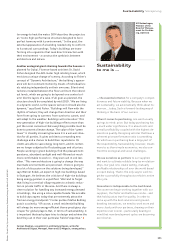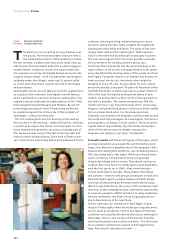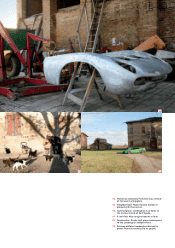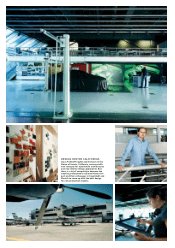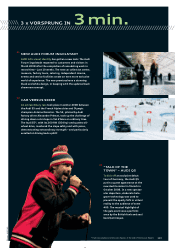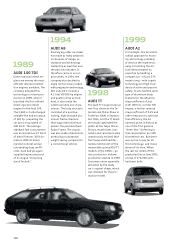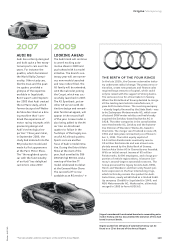Audi 2008 Annual Report Download - page 114
Download and view the complete annual report
Please find page 114 of the 2008 Audi annual report below. You can navigate through the pages in the report by either clicking on the pages listed below, or by using the keyword search tool below to find specific information within the annual report.
111
Imagination Vorsprung
for design strategy at Audi. A city like
Munich is a great place to come up
with new ideas. For instance, is there
something to be learned from the air-
filled foil panels of the Allianz Arena
or the glass windows of the Herz-Jesu
Church? Or could Audi Design derive
something from the detail solutions
used in floating facades? How do the
light fabrics of the new spring collec-
tion handle? Needless to say, they
also engage in dialog with other crea-
tive professionals. Audi Group design
chief Egger says this cultural inter-
change is an important remedy to
tunnel vision.
Auto designers must have a good an-
tenna for esthetic and social currents
and must always be a few years ahead
of what’s currently happening on the
streets. That’s why the creative minds
at Audi are presently focused on
catchwords like “performance ath-
lete,” “new value” and “lightness.”
“Downsizing isn’t just about building
smaller cars,” explains Egger. “Down-
sizing is a strategy. It’s about how we
are going to define luxury in the future.
It’s about simplicity, reduced opu-
lence.” And that’s also how Munich
was able to give impetus for the A1.
The first prototype of the smallest
Audi scheduled to hit the roads in 2010
is distinguished by its aluminum-
colored curved roof, unusually sporty
design for a compact car and typical
Audi front end with its distinctive
single-frame radiator grille.
The Munich designers, of course, also
discuss ideas with their counterparts
in Los Angeles and at Lamborghini
in Sant’Agata, even though the Italian
sports car manufacturer’s Centro Stile
usually works alone on designing
its new models. The Italian creative
team designs almost all its cars
entirely on computer. No full-scale
clay models are built here. Data from
1:4 scale models are transferred
directly to the hard model with unpar-
alleled results: muscle cars with clean
contours, masculine and aggressive.
“A Lamborghini’s look has to aston-
ish,” says Filippo Perini, design chief
of the Lamborghini brand, “because
the brand stands for avant-garde and
provocative design.”
Back to Munich: The casual atmos-
phere betrays nothing of the pressure
the team is working under. “Design is
hard work,” says Monnerjan. “Even two
or three millimeters can dramatically
change the character of a sculpture.”
Despite all their freedom, sooner or
later the Munich designers have to sit
face to face with the design engineers
in Ingolstadt to discuss what is actu-
ally possible on a production scale.
“We can’t sacrifice a single week of
work in this process,” confirms Egger.
He estimates it takes an average of six
months to complete the theoretical
design of a new production model.
Designing a vehicle from the first idea
through sketches, 3D views, clay mod-
els, and ultimately to a full-scale
plastic model with real wheels takes
years. Time and again, its designers
come to the modeling hall to stand
before their creation, relentlessly con-
templating the surface treatment or
countless other details. The design
chief from Ingolstadt uses marking
tape to indicate any changes they
want to make to the model – like
improving the contour of the engine
hood or simplifying a sidewall. There
is significance in every angle; nothing
is left to chance. It is precisely this
obsession with detail that differenti-
ates Audi design. “An Audi has to be
recognizable from a distance of 200
meters,” explains Egger. “Even without
a logo. It’s a goal we are constantly
pursuing.” He likes to speak of a brand’s
DNA; its unmistakable character.
It’s well worth the effort because, un-
like the latest sports shoe collection
that is already out of fashion at the
end of a single season, on average an
Audi will be on the roads for more
than 10 years. In the best case, the
car becomes an icon – like the Audi TT.
Creating a successor to such a car is
one of a designer’s toughest jobs. But
Egger is convinced that even that is
possible if one “uses a freethinking
approach and continues to push ideas
forward.” Like they do in Munich. Of
course, customers have the final vote.
11 flying hours farther west, shortly
before 9 am. Powerful SUVs, sleek
sports cars, vans, pick-ups and conven-
tional sedans are moving bumper to
bumper along urban freeways that
span up to 16 lanes. Welcome to L.A.!
Nowhere else in the world do people
spend more time in their cars than in
California. The VW Group has been
operating the Design Center California
in Los Angeles since 1990 and, since
2006, more than 60 designers, artists,
modelers and engineers have been at
work here at Santa Monica Airport.
L.A. is the ideal environment for Audi
to design new esthetic dimensions far
away from what’s happening at corpo-
rate headquarters.
Ideation is the process of coming up
with the initial concept in automotive
design, and includes the design of
new vehicle architectures and car
bodies as well as the creation of new
interior concepts or even devising
new controls and switches. “Our work
here is akin to basic research and
trend scouting for the automotive
field,” says Jae Min, who is in charge
of Audi Design.
Ideas generated here in close cooper-
ation with Ingolstadt’s design chief
might show up years later as a con-
cept car at one of the big auto shows
or even in production models. Exam-
ples include the conceptual design of
the Audi A4, the first generation of
the TT as well as the current A8 series.
On the three floors of the brightly lit
interior of the off-white building on
Donald Douglas Drive, people are busy
drawing, refining, sculpting, being
confronted with virtual designs – and
asking questions. What will cars of
“Design is hard work. Even two or three milli-
meters can dramatically change the character
of a sculpture.”
Carsten Monnerjan, Head of Concept Design Munich, AUDI AG


